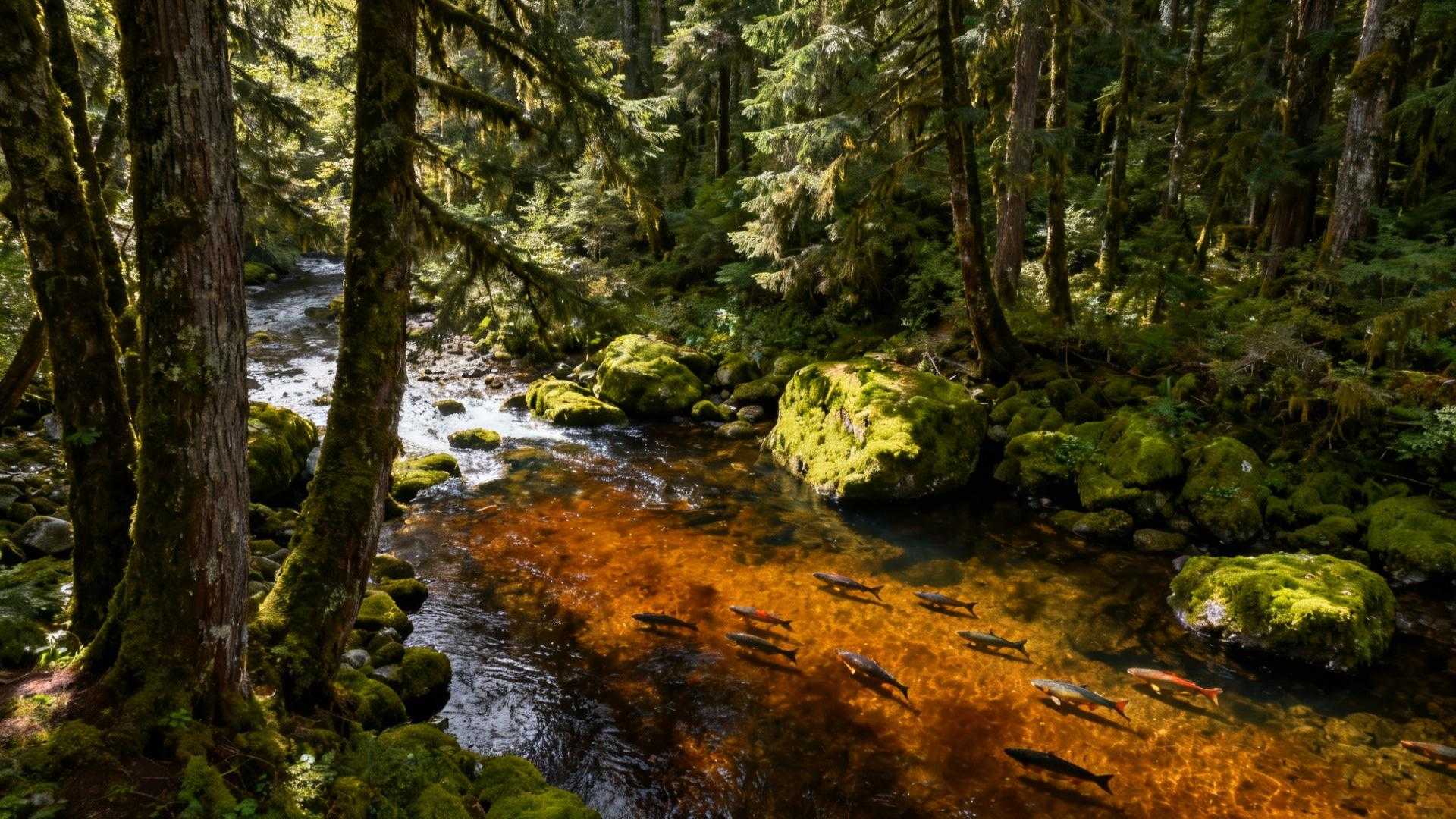Twenty years mapping Alaska’s salmon arteries taught me that numbers lie. We catalogued over 900 streams from Ketchikan to Kotzebue, measuring flow rates and spawning densities with scientific precision. But Chichagof Island’s hidden bays revealed something our data sheets couldn’t capture: the eerie beauty of death feeding life, where October’s spawning salmon paint temperate rainforest floors crimson while bears gorge for hibernation under 200-foot Sitka spruce. The locals call these tucked-away watersheds the Nitrogen Factory, and when I learned about Poison Cove’s 18th-century toxic algae catastrophe that killed Russian fur hunters, I understood why some secrets stay buried in tannin-stained waters.
This isn’t the postcard Alaska cruise ships sell. This is Southeast Alaska’s last intact salmon forest, where pink salmon carcasses fertilize ancient trees and modern researchers still decode historical algal bloom mysteries that turned productive bays into graveyards.
The toxic history locals whisper about
Why Poison Cove earned its deadly name
Chichagof Island’s coastline hides place names that make cartographers uncomfortable. Poison Cove, Deadman’s Reach, Peril Strait—these aren’t marketing gimmicks. In the late 1700s, Russian fur seal hunters died here from paralytic shellfish poisoning during massive algal blooms. Recent research by the Southeast Alaska Tribal Ocean Research network confirmed that harmful algal blooms still spike unpredictably, with 2025 marking the earliest recorded event since monitoring began in 2016. The ocean remembers what we forget.
Modern algae research reveals uncomfortable patterns
Scientists analyzing over 1,700 shellfish samples since 2016 discovered toxin concentrations exceeding FDA safety thresholds by 400% in blue mussels and butter clams during peak blooms. Climate change is erasing the old “safe during months with ‘R'” rule. October’s warming waters now trigger unpredictable blooms, making the salmon forest ecosystem both more vulnerable like California’s protected tide pools and more hauntingly beautiful as decomposing salmon release nitrogen into waters already stressed by algae.
Where dead salmon build living cathedrals
The science behind forest fertilization most visitors miss
Walk Tenakee Inlet’s stream banks in October and you’ll witness ecological alchemy. Pink salmon carcasses decompose, releasing marine-derived nitrogen that isotope studies trace directly into spruce needles, devil’s club leaves, and moss carpets. This nutrient transfer sustains one of Earth’s rarest biomes—temperate rainforests covering less than 1% of global land yet hosting biodiversity density rivaling tropical jungles. The forest literally grows from the ocean, tree ring by tree ring.
Why locals call it the Nitrogen Factory
Biologists estimate 70% of forest nutrients in these watersheds originate from salmon bodies. Bears accelerate the process, dragging carcasses into understory thickets where decomposition feeds fungi, insects, and ultimately the towering Sitka spruce that define Southeast Alaska’s skyline. You’re not just watching salmon spawn—you’re witnessing multi-kingdom collaboration that predates human language.
The bear country protocols that protect both species
Coexistence rules that actually work
Chichagof Island sustains some of North America’s highest grizzly bear densities—one bear per square mile in prime salmon habitat. October transforms these bays into feeding frenzies as bears pack on winter fat. Respectful observation means keeping 100 yards minimum distance, carrying bear spray (not using it as repellent), and never approaching carcass piles. This isn’t Kenai River’s boardwalk viewing. This is wild encounter territory like Grenada’s untouched islets, where animals dictate terms.
What Tlingit protocols teach about watching
Indigenous communities who’ve stewarded these watersheds for 10,000 years practice observational humility. Don’t interfere with subsistence fishing. Don’t block stream access. Don’t treat spawning grounds like photo studios. The Tlingit concept of haa aaní (our land) reminds visitors that invitation isn’t ownership—it’s borrowed privilege requiring gratitude expressed through restraint.
Why this stays Alaska’s under-visited secret
Access that filters casual tourists naturally
No roads penetrate Chichagof’s salmon forest core. Float plane charters from Juneau or Sitka run $500-800 roundtrip, weather permitting. October’s unpredictable storms cancel flights frequently. This geographic isolation protects the ecosystem better than any regulation, ensuring that visitor numbers stay manageable like New Zealand’s protected island sanctuaries. The forest doesn’t want fame—it wants survival.
The conservation tension that defines October visits
Every visitor adds pressure to fragile spawning habitat. Every photograph risks revealing location details that invite crowds. My two decades studying these streams taught me that some secrets protect themselves through difficulty of access, unpredictable weather, and the sobering reality that algal toxins still claim lives. The salmon forest doesn’t need more admirers—it needs more defenders willing to love it from a distance.
Planning a salmon forest visit: practical reality check
When to visit and what to expect honestly
October offers peak salmon spawning, autumn gold foliage against evergreen backdrop, and 55°F average temperatures with constant rain probability. Bear activity peaks as hibernation approaches. Book float plane access three months ahead, carry waterproof everything, and accept that weather cancellations happen. This isn’t vacation—it’s pilgrimage requiring flexibility and respect.
The costs that filter mindful travelers
Beyond transport, factor guided ecotour costs ($300-500 daily), bear safety courses (mandatory for backcountry access), and Leave No Trace certification. Compare this to Kenai River’s $150 boardwalk tours hosting 50,000 summer visitors, and you understand why Chichagof remains authentically wild. The forest charges admission in effort, not dollars.
Questions about Alaska’s hidden salmon forests
Is it safe to visit during algal bloom season?
Monitor Alaska Department of Health shellfish safety advisories before traveling. Never harvest or consume local shellfish without confirming current toxin levels. The 2025 early April bloom demonstrates that traditional seasonal safety patterns no longer apply—climate change has made harmful algal blooms unpredictable year-round.
How does this compare to famous salmon viewing spots?
Kenai River and Russian River offer accessible, crowded viewing with boardwalks and rangers. Chichagof demands self-sufficiency, wilderness skills, and acceptance that bears own the territory. You trade convenience for authenticity, comfort for ecological immersion that most Alaska tourists never experience.
What’s the ethical way to photograph salmon spawning?
Stay on designated trails or gravel bars. Never wade through spawning areas or handle fish. Use telephoto lenses instead of approaching closely. Prioritize ecosystem health over perfect shots—your presence already impacts the delicate balance between salmon, bears, and forest regeneration.
